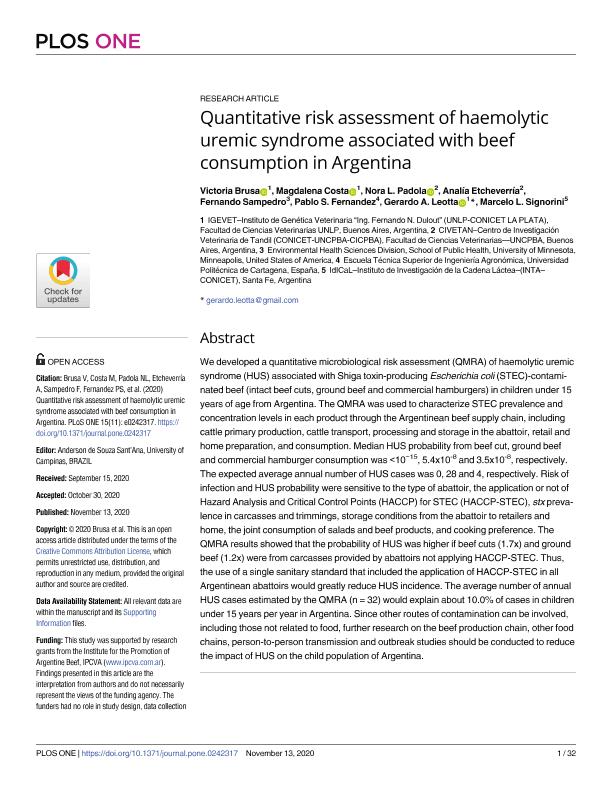Mostrar el registro sencillo del ítem
dc.contributor.author
Brusa, Victoria

dc.contributor.author
Costa, Magdalena

dc.contributor.author
Padola, Nora Lía

dc.contributor.author
Etcheverría, Analía Inés

dc.contributor.author
Sampedro, Fernando
dc.contributor.author
Fernandez, Pablo S.
dc.contributor.author
Leotta, Gerardo Anibal

dc.contributor.author
Signorini Porchietto, Marcelo Lisandro

dc.date.available
2021-08-20T01:42:38Z
dc.date.issued
2020-11-13
dc.identifier.citation
Brusa, Victoria; Costa, Magdalena; Padola, Nora Lía; Etcheverría, Analía Inés; Sampedro, Fernando; et al.; Quantitative risk assessment of haemolytic uremic syndrome associated with beef consumption in Argentina; Public Library of Science; Plos One; 15; 11; 13-11-2020; 1-32
dc.identifier.issn
1932-6203
dc.identifier.uri
http://hdl.handle.net/11336/138564
dc.description.abstract
We developed a quantitative microbiological risk assessment (QMRA) of haemolytic uremic syndrome (HUS) associated with Shiga toxin-producing Escherichia coli (STEC)-contaminated beef (intact beef cuts, ground beef and commercial hamburgers) in children under 15 years of age from Argentina. The QMRA was used to characterize STEC prevalence and concentration levels in each product through the Argentinean beef supply chain, including cattle primary production, cattle transport, processing and storage in the abattoir, retail and home preparation, and consumption. Median HUS probability from beef cut, ground beef and commercial hamburger consumption was <10−15, 5.4x10-8 and 3.5x10-8, respectively. The expected average annual number of HUS cases was 0, 28 and 4, respectively. Risk of infection and HUS probability were sensitive to the type of abattoir, the application or not of Hazard Analysis and Critical Control Points (HACCP) for STEC (HACCP-STEC), stx prevalence in carcasses and trimmings, storage conditions from the abattoir to retailers and home, the joint consumption of salads and beef products, and cooking preference. The QMRA results showed that the probability of HUS was higher if beef cuts (1.7x) and ground beef (1.2x) were from carcasses provided by abattoirs not applying HACCP-STEC. Thus, the use of a single sanitary standard that included the application of HACCP-STEC in all Argentinean abattoirs would greatly reduce HUS incidence. The average number of annual HUS cases estimated by the QMRA (n = 32) would explain about 10.0% of cases in children under 15 years per year in Argentina. Since other routes of contamination can be involved, including those not related to food, further research on the beef production chain, other food chains, person-to-person transmission and outbreak studies should be conducted to reduce the impact of HUS on the child population of Argentina.
dc.format
application/pdf
dc.language.iso
eng
dc.publisher
Public Library of Science

dc.rights
info:eu-repo/semantics/openAccess
dc.rights.uri
https://creativecommons.org/licenses/by-nc-sa/2.5/ar/
dc.subject
QUANTITATIVE RISK ASSESSMENT
dc.subject
STEC
dc.subject
BEEF MEAT
dc.subject
PUBLIC HEALTH
dc.subject.classification
Ciencias Veterinarias

dc.subject.classification
Ciencias Veterinarias

dc.subject.classification
CIENCIAS AGRÍCOLAS

dc.title
Quantitative risk assessment of haemolytic uremic syndrome associated with beef consumption in Argentina
dc.type
info:eu-repo/semantics/article
dc.type
info:ar-repo/semantics/artículo
dc.type
info:eu-repo/semantics/publishedVersion
dc.date.updated
2021-04-28T20:07:42Z
dc.journal.volume
15
dc.journal.number
11
dc.journal.pagination
1-32
dc.journal.pais
Estados Unidos

dc.journal.ciudad
San Francisco
dc.description.fil
Fil: Brusa, Victoria. Consejo Nacional de Investigaciones Científicas y Técnicas. Centro Científico Tecnológico CONICET- La Plata. Instituto de Genética Veterinaria "Ing. Fernando Noel Dulout". Universidad Nacional de La Plata. Facultad de Ciencias Veterinarias. Instituto de Genética Veterinaria; Argentina
dc.description.fil
Fil: Costa, Magdalena. Consejo Nacional de Investigaciones Científicas y Técnicas. Centro Científico Tecnológico CONICET- La Plata. Instituto de Genética Veterinaria "Ing. Fernando Noel Dulout". Universidad Nacional de La Plata. Facultad de Ciencias Veterinarias. Instituto de Genética Veterinaria; Argentina
dc.description.fil
Fil: Padola, Nora Lía. Consejo Nacional de Investigaciones Científicas y Técnicas. Centro Científico Tecnológico Conicet - Tandil. Centro de Investigación Veterinaria de Tandil. Universidad Nacional del Centro de la Provincia de Buenos Aires. Centro de Investigación Veterinaria de Tandil. Provincia de Buenos Aires. Gobernación. Comision de Investigaciones Científicas. Centro de Investigación Veterinaria de Tandil; Argentina
dc.description.fil
Fil: Etcheverría, Analía Inés. Consejo Nacional de Investigaciones Científicas y Técnicas. Centro Científico Tecnológico Conicet - Tandil. Centro de Investigación Veterinaria de Tandil. Universidad Nacional del Centro de la Provincia de Buenos Aires. Centro de Investigación Veterinaria de Tandil. Provincia de Buenos Aires. Gobernación. Comision de Investigaciones Científicas. Centro de Investigación Veterinaria de Tandil; Argentina
dc.description.fil
Fil: Sampedro, Fernando. University Of Minnesota. School Of Public Health.; Estados Unidos
dc.description.fil
Fil: Fernandez, Pablo S.. Universidad Politécnica de Cartagena; España
dc.description.fil
Fil: Leotta, Gerardo Anibal. Consejo Nacional de Investigaciones Científicas y Técnicas. Centro Científico Tecnológico CONICET- La Plata. Instituto de Genética Veterinaria "Ing. Fernando Noel Dulout". Universidad Nacional de La Plata. Facultad de Ciencias Veterinarias. Instituto de Genética Veterinaria; Argentina
dc.description.fil
Fil: Signorini Porchietto, Marcelo Lisandro. Consejo Nacional de Investigaciones Cientificas y Tecnicas. Centro Cientifico Tecnologico Conicet - Santa Fe. Instituto de Investigacion de la Cadena Lactea. - Instituto Nacional de Tecnologia Agropecuaria. Centro Regional Santa Fe. Estacion Experimental Agropecuaria Rafaela. Instituto de Investigacion de la Cadena Lactea.; Argentina
dc.journal.title
Plos One

dc.relation.alternativeid
info:eu-repo/semantics/altIdentifier/url/https://journals.plos.org/plosone/article?id=10.1371/journal.pone.0242317
dc.relation.alternativeid
info:eu-repo/semantics/altIdentifier/doi/https://doi.org/10.1371/journal.pone.0242317
Archivos asociados
